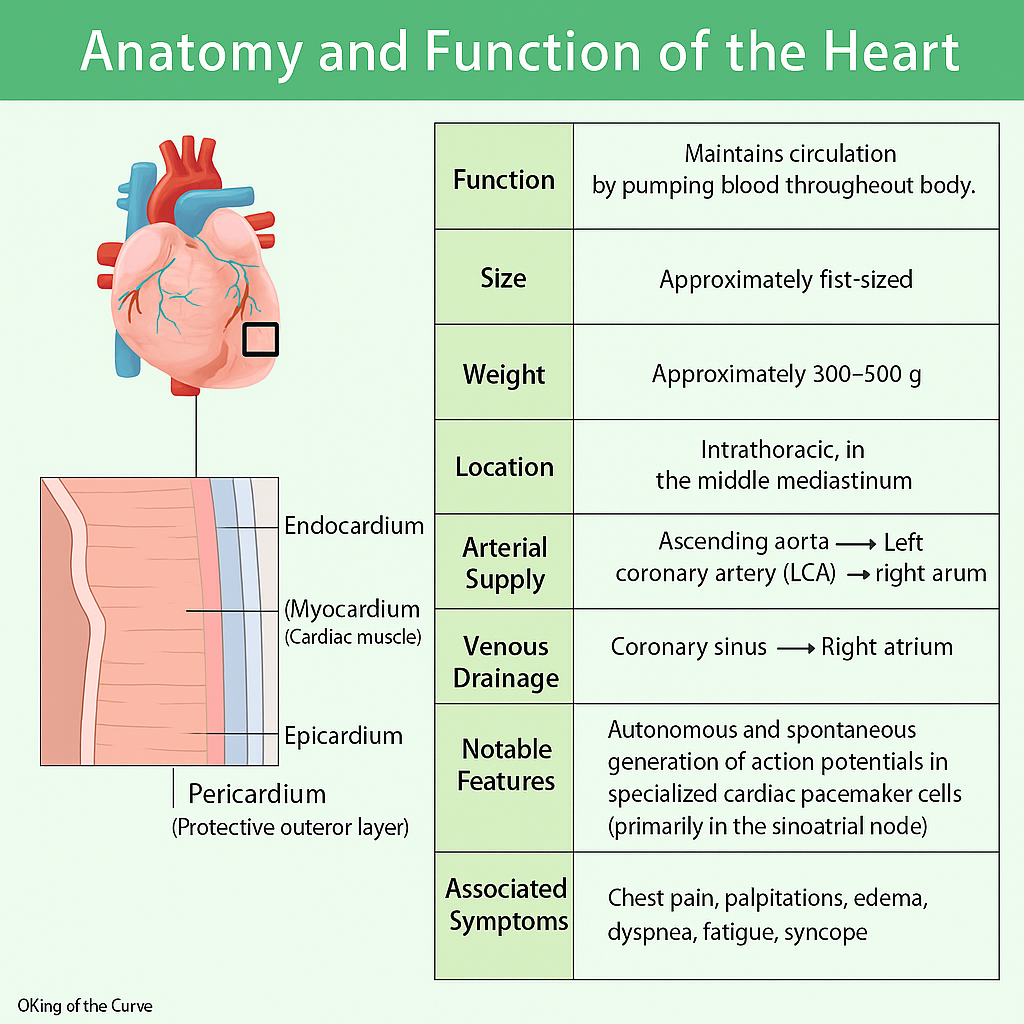🫀 Heart Anatomy & Function: The Core of Cardiovascular Mastery
Whether you’re studying for the MCAT, preparing for USMLE Step 1, or reinforcing concepts for the NCLEX, mastering the structure and function of the heart is non-negotiable. Today’s infographic from King of the Curve simplifies the essentials—from layers of the heart wall to arterial supply and common symptoms—making it easy to remember under pressure.
🧠 Quick Overview: Heart Basics
Hello, World!
🧬 Heart Wall Layers (MCAT/Step 1 Must-Know)
Endocardium – inner lining; site of infective endocarditis.
Myocardium – thick muscle layer; most common site of infarction.
Epicardium – outermost layer; part of the visceral pericardium.
Pericardium – protective sac; inflammation here = pericarditis.
🧠 MCAT Tip: Look for questions that test your ability to localize diseases based on symptoms (e.g., pericardial rub → pericarditis).
🔄 Blood Supply & Drainage
Arterial Supply:
Left Coronary Artery (LCA)
Right Coronary Artery (RCA)
Originates from the ascending aorta
Venous Drainage:
Coronary sinus drains into the right atrium
🩺 Step 1 Tip: Expect clinical vignettes involving coronary occlusion or ischemic changes. Know which artery supplies which region of the myocardium!
⚡ Special Features of Cardiac Tissue
The heart has automaticity—it doesn’t need neural input to beat.
The sinoatrial (SA) node generates spontaneous action potentials.
This automatic control can be overridden by sympathetic/parasympathetic input.
🧠 MCAT/Step 1 Tip: Test writers love comparing pacemaker physiology to skeletal muscle. Focus on ion channel differences.
🩺 Symptoms of Dysfunction: Clinical Anchors
Chest pain
Palpitations
Dyspnea (shortness of breath)
Fatigue & Syncope (fainting)
Peripheral edema
🧠 NCLEX Tip: Heart failure patients may present with dyspnea, fatigue, and swelling. Know how these relate to the heart’s pumping ability and preload/afterload.
📘 Study Smarter with King of the Curve
Want to make memorization effortless? KOTC makes it visual and gamified.
🧠 1000+ high-yield visuals
🔁 Daily MCAT & Step 1 drills
🎮 Adaptive multiplayer mode
💰 Curve Coins to track mastery
🎯 Try Free: https://kingofthecurve.org/free-lifetime
📚 Explore Pre-Med Essentials: https://kingofthecurve.org/pre-med-essentials
✅ Conclusion
Understanding the structure and function of the heart is a gateway to mastering cardiovascular physiology and pathology. With today’s KOTC visual, you’ve got the essentials covered in one glance—exactly how long-term learning should feel.
Frequently Asked Questions (FAQs)
-
Aim for 4-6 focused hours, ensuring you incorporate breaks to avoid burnout.
-
Practice mindfulness techniques, take practice exams under realistic conditions, and maintain a balanced lifestyle.
-
Set short-term goals, seek support from mentors, and reward yourself for small achievements.
-
Regular exercise improves focus, reduces stress, and enhances overall mental clarity.
-
KOTC offers personalized learning tools, gamification features, and adaptive question banks to help students stay on track without burnout.


